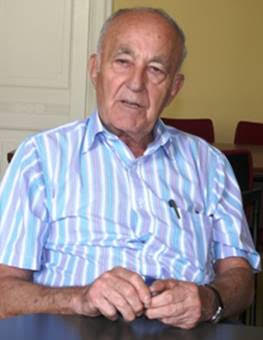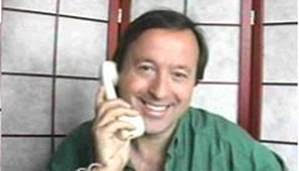
THE VOICE OF INTERNATIONAL LITHUANIA
|
VilNews has its own Google archive! Type a word in the above search box to find any article.
You can also follow us on Facebook. We have two different pages. Click to open and join.
|
Front page
Thanksgiving
- Posted by - (1) Comment
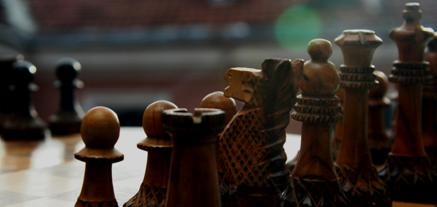
The chess game that Pedro’s father made by his own hands.
Photo: Aage Myhre.
My friend, a journalist with the name Pedro, from Chile, gave me this chess game in 1987. At the end of the 1970s he had become victim of the military rule of Dictator Augusto Pinochet in his home country. Pedro had written some slightly critical comments about the General in his newspaper, and was given 24 hours to disappear out of Chile. The chess game was the only thing he brought with him in the backpack, except the bare necessities of clothing and food. It was his father who had carved the beautiful pieces out of wooden blocks, and the game was, therefore, the dearest object Pedro owned. He had over some time come to live in political asylum in Norway and had lived in Oslo for a few years when I met him. After a time of acquaintance he gave the chess game to me. He explained the reason: "You are the first and only Norwegian I have been able to communicate with, the only one who has shown me respect and interest since I came here."
The chess game I got from Pedro is standing here, next to me. Just to look at it makes me think. I think of a father who sat for months and cut out each individual shape very accurately and carefully from pieces of wood he had collected. I know that Pedro had been seeking asylum in Norway because he had told the truth about the abuser Pinochet. I know he spent several years in Norway without being met with genuine interest and love. The fact that my nation’s people, so quick and clever when it comes to aid and support of other peoples, not always is very good at communicating face-to-face with people who desperately need someone to talk to.
I'm glad I could play a role in Pedro's life. I am very grateful for the gift he gave me. The dearest object Pedro owned has become extremely dear to me. For all that it represents and communicates.
Thanksgiving Day is Thursday 24 November
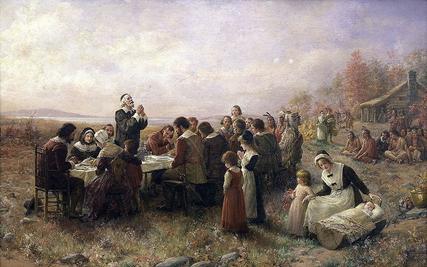
The First Thanksgiving at Plymouth.
By Jennie A. Brownscombe. (1914).
- Bookmark :
- Digg
- del.icio.us
- Stumbleupon
- Redit it
- Posted by - (0) Comment
A Lithuanian twist to
Thanksgiving this year?

Thanksgiving is a way for Lithuanian immigrants to celebrate being in America and to share that celebration with everyone in the nation—from the descendants of the people who arrived here on the Mayflower to a family that arrived here last year.
When families immigrate to the United States, they often keep to the foods of their native countries. They also tend to continue their traditional holidays. The one American event that gets incorporated into the holiday cycle of almost every new arrival is Thanksgiving. It usually includes all the traditional foods—turkey, stuffing, pumpkin pie, sweet potatoes, cranberries and popcorn, but often with unusual twists that reflect our original homeland.
Any unusual twists on a Lithuanian-American Thanksgiving?
From THE LITHUANIAN RAT PACK, Arizona, USA.
- Bookmark :
- Digg
- del.icio.us
- Stumbleupon
- Redit it
- Posted by - (0) Comment
NEW YORK TIMES:
Vilnius among the 10
hippest world cities!

Vilnius early this morning, Sunday 20 November 2011.
Youngsters lighting candles at the Cathedral
to mourn people killed in traffic accidences.
Photo: Aage Myhre
“Hip cities that think about how they work. The story of young people, full of ambition, energy, skill and talent, moving to enticing cities that call to them like a siren’s song is as old as modern civilization. And in a world where national borders are easier to traverse, where more countries are joining the prosperous global middle class and where the cost of a one-way plane ticket is more affordable, young professionals probably have more cities to choose from than ever before.”
This is how New York Times this week introduces its article about what they consider the 10 hippest cities in the world. Vilnius being one of them.
Click here to read the New York Times article
![]()
“The corrupt neoliberal mayor of Vilnius managed to brainwash even New York Times”
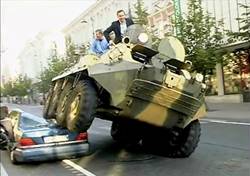
Vilnius Mayor, Arturas Zuokas crushing
an illegally parked car with an armed
vehicle from the Lithuanian army.
Not everyone is impressed by the New York Times’ selection of Vilnius among the top ten hip cities in the world. Here are two comments from Facebook this morning:
1) “My dislike for Vilnius aside, this kind of publicity is very important and would be valuable, if only different aspects were stressed and many of the statements weren't propaganda”
2) “Oh come on, this Zuokas' neoliberalism is way overrated while his public relations drive is closer to idiocy than propaganda. I happened to get in touch with some of his apparatchiks with the city hall's PR and press offices; I'm telling you, they could barely qualify to work for a kolkhoz. The dude is very funny for an ex-convict though, a good journalistic back scratch.”
![]()
Here is MY Vilnius – of today:

Aage Myhre,
Editor-in-Chief.
I took to the streets of Vilnius early today morning, Sunday 20 November.
It was a mysterious, misty morning, excellent for photographing. If you want to see a slide show of my early morning impressions, simply click on one of the below images:
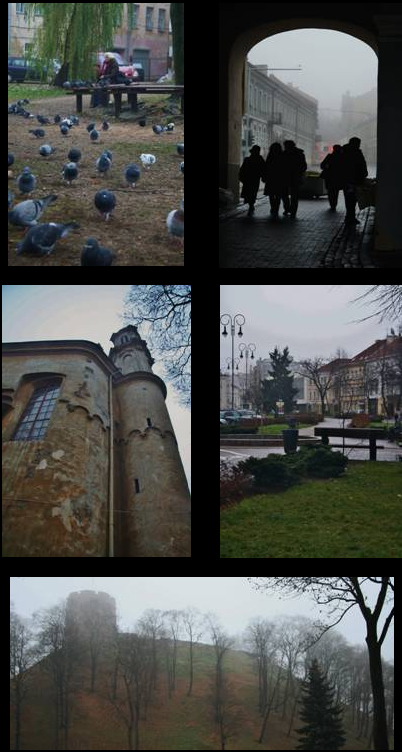
Click here to see my misty early Sunday morning slide show.
- Bookmark :
- Digg
- del.icio.us
- Stumbleupon
- Redit it
- Posted by - (6) Comment
The power of words
This short film illustrates the power of words to radically change your message and your effect upon the world.
Homage to Historia de un letrero, The Story of a Sign by Alonso Alvarez Barreda Music by: Giles Lamb http://www.gileslamb.com Filmed by www.redsnappa.com Director Seth Gardner. Cast: Bill Thompson, Beth Miller http://www.uk.castingcallpro.com/view.php?uid=217905
VilNews: Almost 200,000 visitors in only nine months!
Speaking of the word power: Our VilNews e-magazine has now been online for nine months. When we started the experts said that we probably would reach a readership of around 10 to 15,000 per year. It is therefore with great pleasure we can reveal that we already are approaching 200,000 visits, an incredibly large and gratifying number! We thank you, dear readers, for the enormous interest you are showing VilNews every single day!
- Bookmark :
- Digg
- del.icio.us
- Stumbleupon
- Redit it
- Posted by - (0) Comment
Mark your calendars:
The Christmas Charity Bazaar will take place on Saturday 3 December!

‘Team Ireland’ at last year’s bazaar.
The 9th International Christmas Charity Bazaar (ICCB) will take place on Saturday, 3 December, 2011 at the Vilnius Town Hall (Rotuše) under the kind patronage of Mrs Alma Adamkiene. The Bazaar, organised by the International Women’s Association of Vilnius (IWAV) in cooperation with the international diplomatic and business communities and Lithuanian friends, has become the unofficial start to the Christmas season.
The 2010 event was attended by more than 5.000 visitors and raised nearly 300.000 Litas for beneficiaries, including: Kaunas Medical University Clinic, Vilnius Residential Home for Children and Youth, Ekklesia Charity Foundation, Vilnius University Children's Oncology Unit, Kijeliu Home for Severely Disabled Children (specialusis ugdymo centras), Alantos Nursing Home for the Elderly, Children-Youth Day Care Centre “Musu Namelai”, and the Training Centre for the Blind and Visually Impaired. More information is available from: www.iwavilnius.com/iccb.
- Bookmark :
- Digg
- del.icio.us
- Stumbleupon
- Redit it
Christmas Charity Bazaar background
- Posted by - (0) Comment
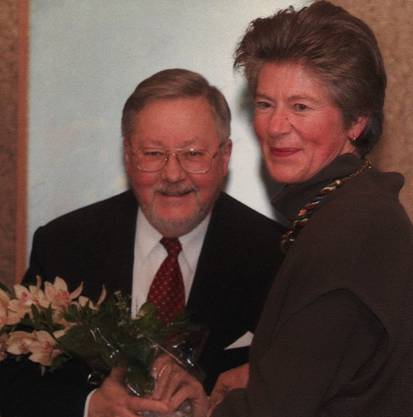
Gunilla Possenius with Professor Vytautas Landsbergis.
By: Gunilla Possenius
Vilnius´ International Christmas Charity Bazaar is approaching - but how and when did it start?
For the ninth year Vilniaus Rotuse will open its doors for the International Christmas Charity Bazaar (ICCB) on December 3. This annual event has become one of the true signs that Christmas is approaching.
But how many know today how it all really started? Over the years, inaccurate information regarding how ICCB started was circulating. So now it is time for the true story to be told.
- Bookmark :
- Digg
- del.icio.us
- Stumbleupon
- Redit it
- Posted by - (0) Comment
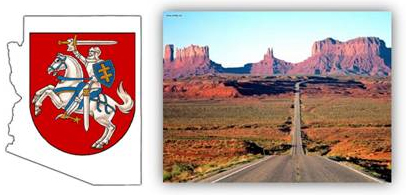
10 000 Lithuanians live
in Arizona, USA
“More than national pride, being Lithuanian is a state of mind.” This can be read at a new Facebook page, “Lithuanians of Arizona”, which was recently established.
Some active individuals among the approximately 10 000 Lithuanians who live in this hot state at the border of Mexico have decided to create a new communication platform to better achieve dialogue and information exchange between all Lithuanians who live in the state. The initiative for the Facebook page was taken after a large picnic event early this November. This is what the initiators write:
“During the annual Arizona Lithuanian Community Picnic in Tumbleweed Park, in Chandler, Arizona, we decided to start a Facebook group to complement the www.lithaz.org web site. This group is dedicated to Lithuanians in Arizona, around the world, or to anyone who is Lithuanian in mind and spirit.”
VilNews applauds the initiative, and we are happy to make our columns available to news updates and information from Arizona and other states or countries where Lithuanians live!
Lithuanians Of Arizona are now on Facebook.
Click here to join them!
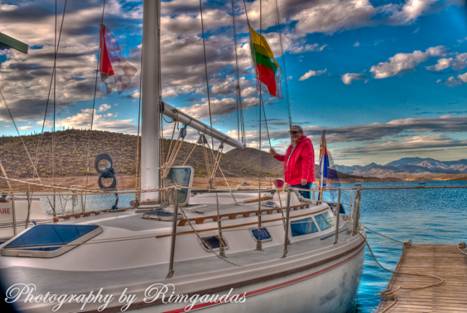
"I found the Lithuanian Flag at Scorpion Bay Marina, Lake Pleasant Arizona, United States of America aboard "Miss Behavin III". 12 November 2011.
Photography by Rimgaudas
Rimgaudas P. Vidziunas aka "Rim", Mesa, Arizona
- Bookmark :
- Digg
- del.icio.us
- Stumbleupon
- Redit it
- Posted by - (0) Comment
|
Lithuanians started to come to Arizona before World War I. Then, as now, it was the warm and dry climate of Phoenix and Tucson, located in the desert regions of southern Arizona, that attracted them. The first Lithuanians came to Arizona to recover from lung illnesses, rheumatism or arthritis. Being ill and few in number, they did not leave a major cultural legacy. Where is Arizona? Read more about Arizona at: |
U.S. Census:
|
- Bookmark :
- Digg
- del.icio.us
- Stumbleupon
- Redit it
- Posted by - (0) Comment
How I came to Lithuania 21 years ago (6 of 6)
Some private memories by Aage Myhre, VilNews Editor-in-Chief
aage.myhre@VilNews.com
1991: Oslo and Vilnius
become twin cities
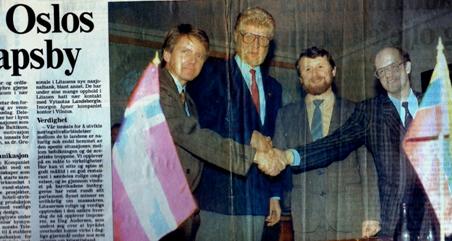
21 January 1991. Soviet military vehicles dominate the streets of Vilnius. Dag Andersen and the author conveys a letter from Oslo, signed by Mayor Michael Tetzschner. Oslo offers Vilnius to become its first friendship city in the West. The letter was enthusiastically received by the Vilnius Mayor Arunas Grumadas and Deputy Mayor Regimantas Ciupaila.
Facsimile: Aftenposten, Norway.
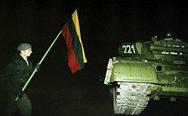 |
Heavy tanks were used by the Soviet forces when they attacked the TV tower and the Parliament building in Vilnius on 13 January 1991 (left). They were met by a wall of unarmed people who refused to allow the intruders to again take control of their homeland. Inside the city they used armoured vehicles on rubber wheels (below). | ||
| It was a bizarre, almost surreal experience to always be spotting, hearing the noise, feel the ground tremble when we were in meetings or trying to get a meal in one of the city's few restaurants. | |||
We often did our eating and drinking in Hotel Lietuva, in the so-called 'Black Bar', where only western, hard currency was accepted. This bar was the centre for international media those January days. Every night we heard stories about howtelevision crews and journalists had experienced rather harsh confrontations with Soviet military units. |
|
||
We were two Norwegians working very much with Lithuanian affairs at this time, Dag Andersen and me. During our visit to Vilnius in January 1991, we brought with us a letter from the city council leader in Oslo, inviting the mayor of Vilnius to sign a sister city agreement. We handed the letter over to Mayor Arunas Grumadas on 21 January while Soviet troops were standing around in the streets and armoured vehicles roaring around us.
The twin city agreement was signed a few months later, and Oslo became the first Western city to enter into such an agreement with Vilnius. I see it as an important symbol of friendship and solidarity at a difficult time for a country under tremendous pressure and terrible abuse from their neighbour to the east.
During 1991 I came back to Lithuania several times. I saw more, understood more. The country began in earnest to fascinate me. I was also in Vilnius during the failed coup in Moscow in August 1991, again thrilling days. On the morning of 30 August 1991 I was probably the first person in modern times that got a legal visa directly to the nation of Lithuania, stamped into my Norwegian passport. 30 August 1991 was the day when the Lithuanian migration authorities finally could do so in accordance with international rules. The Soviet Union was finally a horror of the past. Also formally, Lithuania was once again a free and independent country.
50 years of oppression was over!


|
ABOVE: During my first visit to Lithuania, in November 1990, I took this picture at Rotušes Square (Town Hall Square) in Vilnius. This was probably the very last picture ever made of the statue of Vincas Mickevičius-Kapsukas. Next morning he had been knocked down by local activists... |
Vincas Mickevičius-Kapsukas was a communist leader, born 1880 in Būdviečiai, Vilkaviškis district, dead 1935 in Moscow. He was a political activist, fighting Tsar Russia, one of the founders and leaders of the Communist Party of Lithuania and the Lithuanian Soviet Socialist Republic (1918–1919).
After the WWII Soviet occupation of Lithuania, his student Antanas Sniečkus (see our article https://vilnews.com/?p=6598 ) propagated Mickevičius' personality cult. In his honour the city of Marijampolė was renamed Kapsukas (1956–1989) and Vilnius University (1955–1990) bore his name. Two large sculptures of Mickevičius were erected in Vilnius: one here, in front of the Vilnius Town Hall (1962) and another, depicting Mickevičius with Lenin, in Antakalnis (1979).
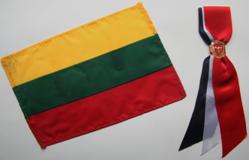
- Bookmark :
- Digg
- del.icio.us
- Stumbleupon
- Redit it
Dates regarding the fall of Soviet communism
- Posted by - (1) Comment
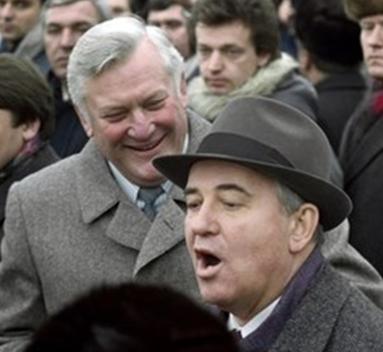
11-13 January 1990 -- one-half of Vilnius’ 600,000 population
demonstrate for pro-independence, to ‘welcome’ visiting
Soviet President Mikhail Gorbachev. Here with the local
communist party leader Algirdas Brazauskas.
By KR Slade
- 1980’s -- economic problems in the USSR; rise of ‘Solidarity’ in Poland
- 1985 -- Soviet President Mikhail Gorbachev announces new Soviet policies of ‘glastnost’ (i.e., ‘political openness’) and ‘perestroika’ (i.e., ‘political and economic restructuring’)
- 3 June 1988 -- in Vilnius, the Lithuanian ‘Sajudis’ (i.e., ‘restructuring’) movement is founded; mostly artists; 17 of the 35 initial members were members of the Communist Party
- 22 October 1988 -- first Sajudis General Congress meets: first organised opposition to the Communist Party
- March-May 1989 -- Sajudis wins legislative seats in the USSR’s highest body of Soviet administration, the Congress of People's Deputies
- February 1989 -- Sąjudis declares Lithuanian ‘independence’, and that Lithuania had been forcibly annexed by the Soviet Union
- May 1989 -- Sajudis proclaims Lithuanian ‘sovereignty’; and declares that Lithuania's incorporation into the Soviet Union was illegal
- 23 August 1989 -- the “Baltic Way”: mass protest of two million people, linking hands in a ‘human chain’, of 650 kilometres: from Vilnius (Lithuania) to Riga (Latvia) to Tallinn (Estonia)
- Bookmark :
- Digg
- del.icio.us
- Stumbleupon
- Redit it
- Posted by - (0) Comment
How I came to Lithuania 21 years ago (5 of 6)
Some private memories by Aage Myhre, VilNews Editor-in-Chief
aage.myhre@VilNews.com
January 1991:
With Landsbergis behind barbed wire and homemade barricades
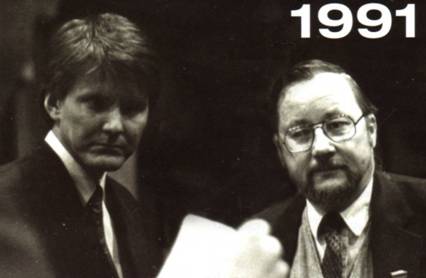
19 January 1991: The author with President Vytautas Landsbergis in the Lithuanian Parliament (Seimas), while the Soviet troops and tanks continue to surround the building.
"Lithuanians, do not resist, your government has betrayed you. Go home to your families and children."
This was the repeated announcement from the Soviet military vehicles with loudspeakers on the roofs, so-called sound trucks, that rolled through the streets of Vilnius in January 1991. But fortunately for Lithuania and the United Europe that we now take more or less for granted, there was a music professor and a complete small nation that wanted it all differently.
Had it not been for this peaceful struggle of recovered freedom against an invasion and occupation, the people of the Baltic States never wanted or agreed to, the map of Europe would most likely have looked quite different today.
If there were those in the West who had not heard of Lithuania before, they almost certainly had by the end of the day 13 January 1991. It was the day that Soviet troops struck in Vilnius. The bloodshed that followed made headlines around the world. The attack was apparently an attempt to stop the Lithuanian independence movement in its very beginning.
When the smoke of the Soviet weapons ceased, more than a dozen people had been killed, hundreds injured. Soviet’s attack, and especially the killings at the TV tower, brought not only fame and sympathy for Lithuania from around the world, it was also a defining moment for the Lithuanians themselves.
The bloodshed meant that a point of no return had been crossed. If there was anyone who until now had believed that a peaceful settlement with Moscow was possible, it was now clear to everyone that such a thing was unthinkable.
To read more, go to our SECTION 13 – THE WORLD IN LITHUANIA
- Bookmark :
- Digg
- del.icio.us
- Stumbleupon
- Redit it
- Posted by - (0) Comment
How I came to Lithuania 21 years ago (4 of 6)
Some private memories by Aage Myhre, VilNews Editor-in-Chief
aage.myhre@VilNews.com
January 1991:
Soviet rolls back
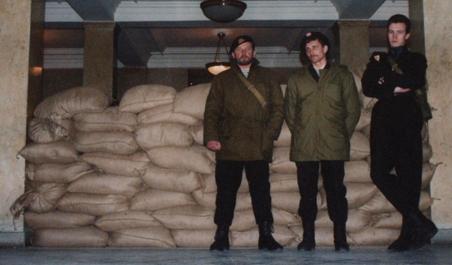
18 January 1991: It is very touching to see how the Balts act to keep their newfound freedom and protect their home country during the very difficult January days of 1991. Here, at the entrance to the Lithuanian Foreign Ministry, the young men have put on homemade clothes that are meant to look like uniforms. They carry rifles and other weapons they have found in their homes. Sand bags have an important symbolic effect. Brave guys!
Photo: Aage Myhre, 18 January 1991.
In the summer of 1990 we heard Parliament President Landsbergis tell us that he feared a new Soviet attack after Lithuania had declared independence in March of that year. “For Gorbachev, our freedom declaration was very hard to accept, although he towards western countries pretended that everything was in perfect order," Landsbergis told us. When we first came to Lithuania the autumn of 1990, finding everything calm and balanced, it was hard to believe that there was any real reason for his fear.
But he's right. In January 1991 Soviet tanks again roll through the streets of the capitals Tallinn, Riga and Vilnius. Soviet Special Forces take control of radio and television stations, surround the parliaments, ready to use armed force against the governments of the three countries. In Vilnius 14 young people are killed in their attempt to stop the attackers.
To read more, go to our SECTION 13 – THE WORLD IN LITHUANIA
- Bookmark :
- Digg
- del.icio.us
- Stumbleupon
- Redit it

Minister Plenipotentiary Rolandas Kacinskas, Ambassador Zygimantas Pavilionis and Harley Felstein, Project Chairperson.
On the evening of Thursday November 3rd, 2011, the Jewish Lithuanian Heritage Project hosted a roundtable “Think Tank” at the Lithuanian Embassy in Washington D.C. The concept of the think tank originated from a white paper prepared by Harley Felstein, Project Chairperson, and Adrienne Oleck, a Board member.
The meeting drew together concerned intellectuals from the Washington D.C. area and from the Lithuanian Embassy, the Honorable Ambassador Zygimantas Pavilionis and Minister Plenipotentiary Rolandas Kacinskas. The theme of the discussion was, "A comprehensive Five Year plan to improve Lithuanian-Jewish relations: Cultivating Sunflowers."
The Sunflower project will create three core programs focusing on:
1) Communication and Dialogue;
2) Youth engagement and education; and
3) Jewish heritage projects including cemetery restoration.
- Bookmark :
- Digg
- del.icio.us
- Stumbleupon
- Redit it
- Posted by - (0) Comment
How I came to Lithuania 21 years ago (3 of 6)
Some private memories by Aage Myhre, VilNews Editor-in-Chief
aage.myhre@VilNews.com
Nov 1990: Oil, a girl and
a satellite system


The next day another Norwegian, from STATOIL, arrives in Vilnius. Last summer the company gave financial support to our works for Lithuania. Now we have invited them to have a look at opportunities in the Baltics.
The two other Norwegians travel 300 kilometres northwest of Lithuania the following day, to Mazeikiai Nafta, the country's oil refinery. They come back late that night. With a new business idea: to extract oil from the refinery site. They say that they have waded in black mud, full of oil from numerous leaks from pipes and tanks. They are both shocked at what they have experienced. Soviet Union in a nutshell.
My task, when my friends are wading in oil, is to meet with Lithuania's communications minister, Kostas Birulis (who strangely is fluent in English).
The reason is that Landsbergis, during his visit to Oslo three months earlier, asked us if it was possible to get a gift from Norway, a satellite antenna / telephone system that could be installed in the Lithuanian parliament. He was afraid that the Soviets could again try to take control of Lithuania and cut the normal telephone connections.
Our task after his visit to Oslo was to try to persuade Norwegian politicians and our Norwegian telecom to provide and install such a gift in Lithuania. Telecom's export director was my great supporter of this. He managed to convince Telecom's CEO to go for the unusual project. A leading Norwegian attorney, Leon Bodd, who later became the General Consul of Lithuania in Norway, was also of great help.
Communications Minister Birulis accepts the agreement which I put before him this November day in 1990. In 1991, all details about the financing and installation of the system were settled in Norway and in autumn it was all completed. A huge satellite dish with 'Telecom' logo adorned the roof of parliament for many years to come. A prominent symbol of solidarity and bilateral thinking.
To read more, go to our SECTION 13 – THE WORLD IN LITHUANIA
- Bookmark :
- Digg
- del.icio.us
- Stumbleupon
- Redit it
- Posted by - (0) Comment
New writer for VilNews
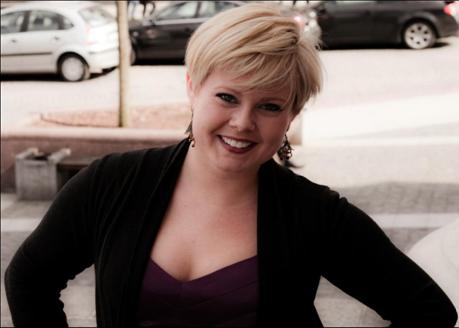
Associate Editor Emily Daina Šaras.
Emily Daina Šaras is a musician, anthropologist, and activist from Hopedale, Massachusetts, USA living and working in Vilnius, Lithuania.
She is currently working as Director of her new music and tolerance project, Dainos for Diversity, and studying vocal performance in the studio of Sigutė Stonytė at the Lithuanian Music and Theatre Academy.
Her music studies and human rights work, both extensions from her work as a Fulbright Fellow in 2010-2011, are supported by a grant from the United States Embassy in Vilnius, Lithuania.
Ms. Šaras graduated Magna cum laude with Departmental Honors from Wellesley College in May 2010 as a double major in Anthropology and Music, focusing her studies on Classical vocal performance. She performs in Lithuania at various events and concerts sponsored by The American Center, and over the last year, she has performed in the Rokiškio Classical Music Festival, the Sacred Music Festival, and at Vilniaus Rotusė.
- Bookmark :
- Digg
- del.icio.us
- Stumbleupon
- Redit it
- Posted by - (0) Comment
How I came to Lithuania 21 years ago (2 of 6)
Some private memories by Aage Myhre, VilNews Editor-in-Chief
aage.myhre@VilNews.com
November 1990: A
Volga journey from Riga
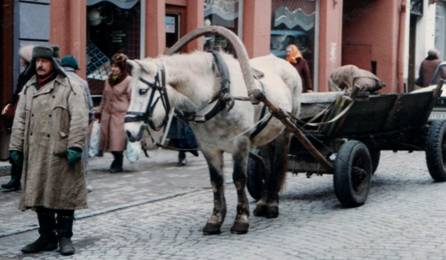
November 1990: Delivery of coal to properties in Pilies g. right in the centre of Vilnius. With horses. People pick it up in burlap sacks. Other times, the horse driver is simply shovelling the coal out on the sidewalk in front of the buildings on the ordering list.
Photo: Aage Myhre.
We land at Riga airport on a late November afternoon in 1990. Flights from western countries are still not allowed to land in Vilnius. A white Volga from the Lithuanian government is waiting for us. The driver is 70. So is the speed (km/h), so it takes us seven hours to be driven the 300 kilometres from Riga to Vilnius. Through Baltic darkness.

We are two Norwegians bumping through Latvia and Lithuania this November evening in a poorly padded back seat. The car has certainly springs and shock absorbers, but they don’t help much. Through Latvia and the northern part of Lithuania the roads are like roads in Norway, narrow and winding. Great is therefore my surprise when half the distance remains and a four-lane highway appears in a country I had expected would only be characterized by worn out poverty! But the top speed of the Volga remains the same.
Almost seven hours have passed when we pass a huge sign. VILNIUS it says, in enormous concrete letters. But it is still dark outside the car windows. Only when we drive down the hill towards the centre, we begin to see some faint lights. Even one neon light. 'Hotel Lietuva' it says. On top of what we understand must be a very tall building. But the darkness dominates entirely. The feeling of the Soviet Union.
"It is better to light a small candle than to curse the darkness." I come to think of words of the Chinese philosopher Confucius (K'ung Fu-tzu). This becomes my motto for my further works in and with Lithuania.
To read more, go to our SECTION 13 – THE WORLD IN LITHUANIA
- Bookmark :
- Digg
- del.icio.us
- Stumbleupon
- Redit it
VilNews e-magazine is published in Vilnius, Lithuania. Editor-in-Chief: Mr. Aage Myhre. Inquires to the editors: editor@VilNews.com.
Code of Ethics: See Section 2 – about VilNews. VilNews is not responsible for content on external links/web pages.
HOW TO ADVERTISE IN VILNEWS.
All content is copyrighted © 2011. UAB ‘VilNews’.

 Click on the buttons to open and read each of VilNews' 18 sub-sections
Click on the buttons to open and read each of VilNews' 18 sub-sections 





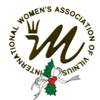


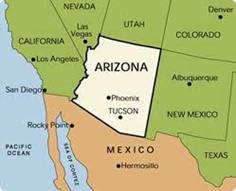
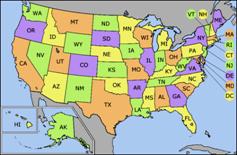

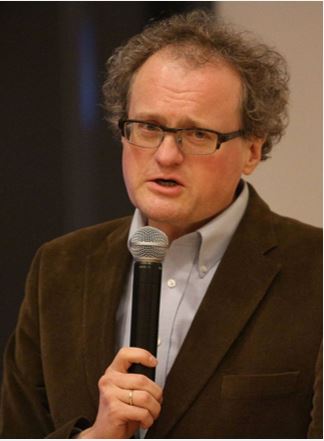

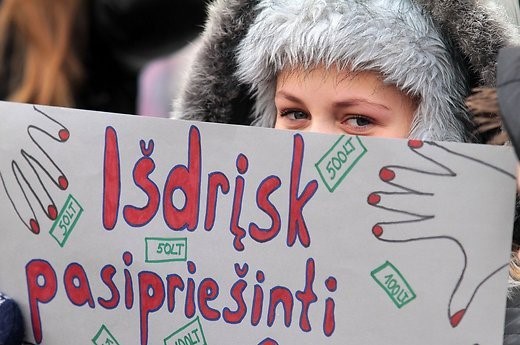


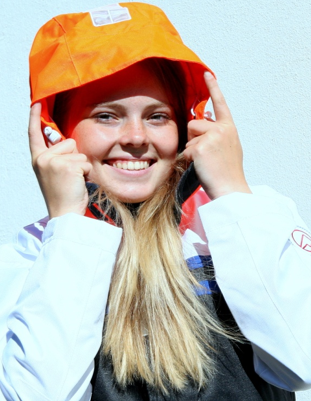
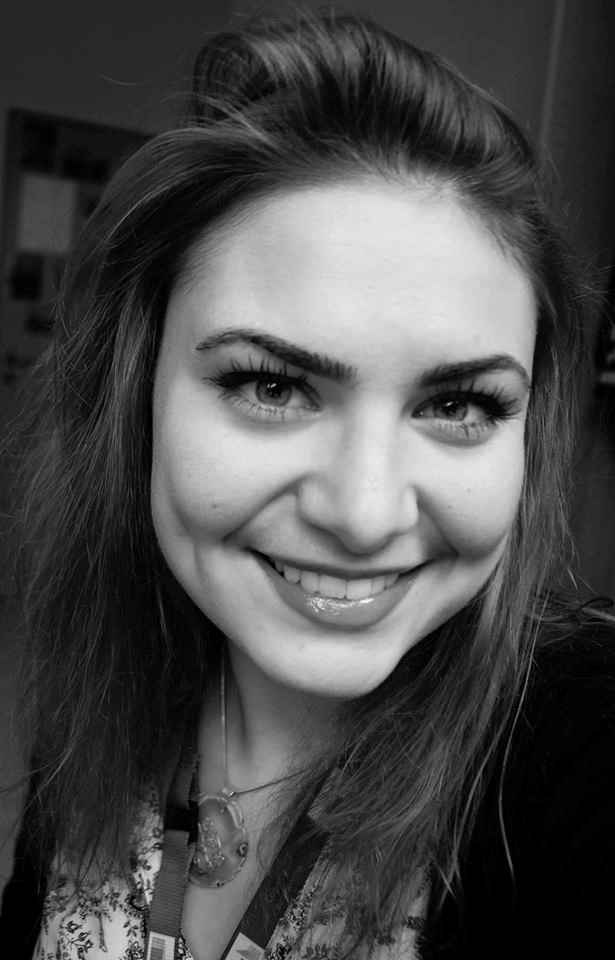

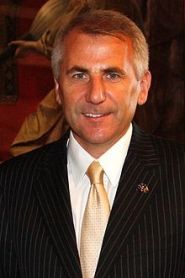
.jpg)
